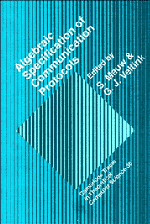Book contents
4 - Sliding Window Protocols
Published online by Cambridge University Press: 03 May 2010
Summary
INTRODUCTION
Sliding Window Protocols are used to provide reliable data communication between two computers in a network environment. A Sliding Window Protocol is connection oriented: a logical connection between the computers is established before data are transferred. Establishing a connection is not part of a Sliding Window Protocol. The connection is supposed to be a point-to-point connection without an intermediate network station. Sliding Window Protocols are situated in the Data Link Layer of the ISO OSI layer model.
In Tanenbaum ([Tan89]) three Sliding Window Protocols are presented. In this chapter a formal specification of these protocols is given. In the remainder of this section we give a general and informal description of a Sliding Window Protocol. In sections 4.2 to 4.4 the different Sliding Window Protocols are introduced and specified in PSF. The communication between Host processes and a Sliding Window Protocol is specified in section 4.5.
GENERAL DESCRIPTION OF A SLIDING WINDOW PROTOCOL
A Sliding Window Protocol (SWP) manages the communication on a point-to-point connection between two computers in a network at the Data Link Layer level in the OSI terminology. A SWP is a full-duplex protocol. This means that data can be transmitted simultaneously from station <I>A to station <I>B and vice versa. On both sides a SWP process is active, taking care of correct transmission. A SWP process contains a sending and a receiving part, managing outgoing and incoming data respectively. As we shall see in the sequel, these parts are not fully separated.
Information
- Type
- Chapter
- Information
- Algebraic Specification of Communication Protocols , pp. 71 - 112Publisher: Cambridge University PressPrint publication year: 1993
Accessibility standard: Unknown
Why this information is here
This section outlines the accessibility features of this content - including support for screen readers, full keyboard navigation and high-contrast display options. This may not be relevant for you.Accessibility Information
- 2
- Cited by
